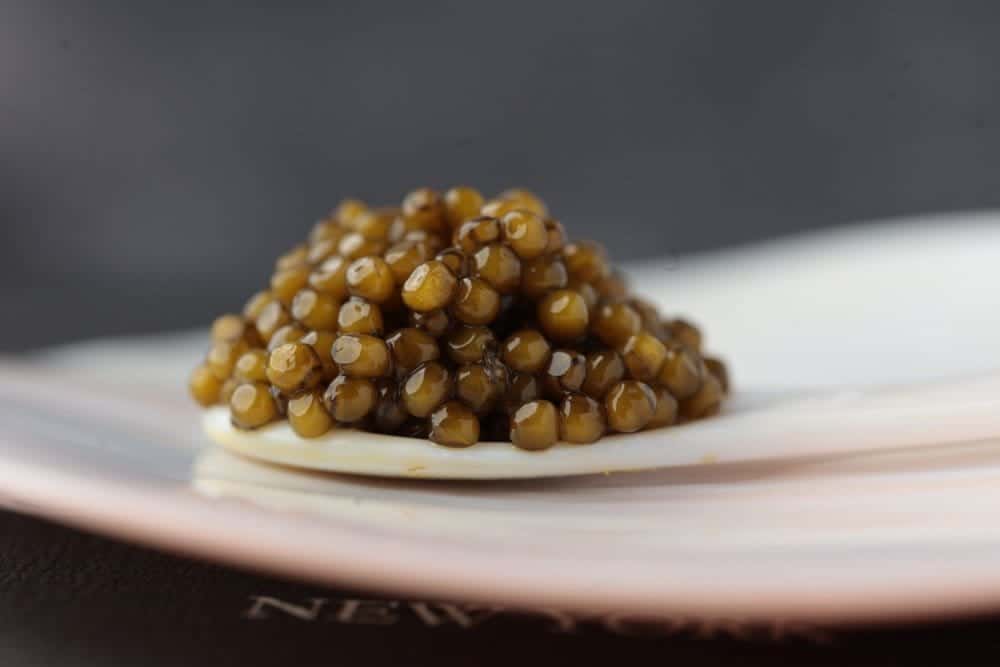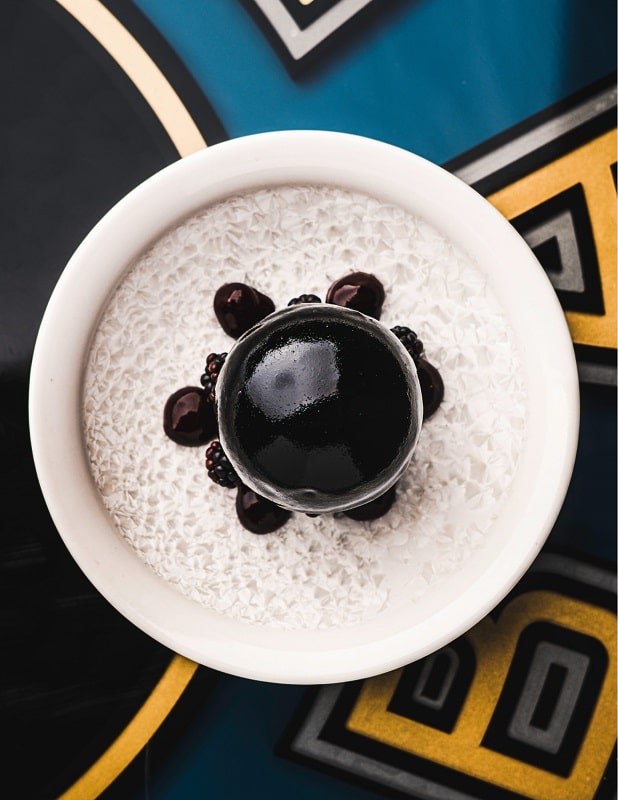11 Things You Didn’t Know About Caviar
Caviar connoisseurs all over the world know how delicious this delicacy is, but some might want to learn what distinguishes it from other fish. We’ll delve into the fascinating world of caviar and reveal some interesting facts that may surprise you. We are AQUA, an elegant upscale restaurant known for fine dining and the best seafood in Las Vegas.
Ready to find out more about caviar? What makes the taste of this ultimate luxury seafood so special? We’ll start with the history of caviar.
1. Where did caviar originate?
The common misconception is that caviar originated from Russia because it was served at lavish imperial banquets for Russian Tsars, most notably for Peter the Great and Nicholas II. However, the legend is that the Persians discovered fish roe from white sturgeon fish in the Caspian Sea in the 9th century. The Persian word havia/havyar translates to fish roe. Russian Imperials subsequently discovered its distinctive taste, making it a popular dish for the upper class and nobility. The Russian word for caviar is ikra.

2. What is caviar?
People can mistakenly assume all caviar is simply the unfertilized eggs of fish. But that’s not exactly true. Caviar is defined as the unfertilized fish eggs, known also as roe, coming specifically from sturgeon fish (Acipenseridae). The delicate caviar is then cured and gently aged in salt as a natural preservative.
3. What is the difference between roe and caviar?
To be clear, caviar is a type of fish roe, but not all fish roe is caviar. In other words, roe can come from a variety of fish, but only caviar comes from sturgeon. Fish roe can come from whitefish, salmon, trout, mackerel, and more. In general, roe can come from various marine animals, such as shrimp, sea urchins, scallops, squid, etc.
4. Does caviar come from sturgeon only in the ocean?
While the history of caviar notes it originates from the Caspian Sea, it can be found outside of saltwater oceans. For example, it can be found in freshwater lakes here in the United States. Sturgeon have been found in river basins on the west coast from California to Alaska. The sturgeon is a huge fish, growing 10 to 20 feet in length, an ancient but gentle giant roaming the oceans for millions of years.
5. What is the color of caviar?
There is a notable color difference between caviar and salmon roe. Caviar’s colors are typically earthy black, dark gray, or dark brown tones. Fish roe from salmon, trout, tobiko, and lumpfish are generally brighter shades of orange and red in color. Therefore, we get the names of red caviar and black caviar.
6. How is caviar made?
Sturgeon are a protected species in the wild, and though fished for centuries in the cold waters of the Caspian Sea, they are now grown on fish farms around the world.
Caviar production is a big business for many countries that have created caviar fish farms. Competing countries are found in Asia, Europe, and North America. The countries with the largest sturgeon fish farms are:
- China and Russia
- United States and Canada
- Italy, France, Spain, Portugal, Poland, Germany, and Bulgaria
The process requires harvesting the whole egg sac from the female sturgeon. It is then gently rinsed and rubbed against a net to separate the eggs. It is then rinsed again and aged in brine salt for at least a month. Once cured, it is put in airtight tin containers and kept at near-freezing temperature to preserve its delicate quality and flavor.
7. What does caviar taste like?
Caviar has a buttery-like taste with an ocean-salty flavor to compliment its creamy inner texture. People love to feel the “pop” of the tiny treat as they bite down. Sturgeon caviar is known for its richness in flavor, much more so than non-sturgeon roe. High-quality caviar is truly a delight for the senses. It is not supposed to smell “fishy” but rather has a faint scent of the sea with an enticing aroma. Anything less than that would make it a lesser-grade caviar.
8. What are the varieties and grades of caviar?
There are 27 sturgeon species worldwide, both in the wild and farmed. Derived from a handful of the species are three of the most popular caviar varieties:
- Beluga or Russian white sturgeon fished from the Caspian Sea produce large gray pearls of buttery fat. It is considered one of the most expensive caviar in the world due to its rarity and has the best quality and taste.
- Osetra caviar comes in second to Beluga, although just as high quality. The Osetra caviar comes from the Russian sturgeon (Acipenser gueldenstaedtii), producing gold to amber-colored roe with a nutty, rich flavor.
- Sevruga is rated as third-tier caviar because, in the past, it became available to the commoners of Russia. The sevruga comes from the smaller starry sturgeon (Acipenser stellatus). It became known for its “rich taste of the sea” yet is the most affordable in terms of price.
There are two grades for every caviar. Grade one indicates a top-tier level of quality, while grade two is below grade one. Grade one is denoted by the firm, rich quality of the eggs. If the sturgeon roe doesn’t meet the standards of grade one quality, it gets labeled as grade two.
9. What is the nutritional value of caviar?
You’ll be happy to know what caviar nutrition facts are helpful to your health. A serving is considered to be one to two ounces per person, or 30 to 50 grams. One caviar serving contains calcium, phosphorus, protein, selenium, iron, magnesium, and Vitamins B12 and B6. It’s also known to be rich in Omega-3s, which is abundant in cold-water fish. Omega-3s are a healthy protection against various ailments such as heart disease and depression.
10. How to eat caviar
It is said not to eat caviar with a silver spoon as the silver can degrade the quality of the caviar. Try using an authentic mother-of-pearl spoon. If that’s not available, put the caviar on a crispy, thin cracker or small piece of artisan bread. Popular pairings with caviar formulate gourmet cuisine for the discerning foodie. Most people think of the popular pairing of a shot of high-quality Vodka to wash down the delicious caviar, but cold Champagne works just as nicely.
Take precautions when storing caviar to ensure optimal freshness. Unopened caviar will last five weeks. Once opened, enjoy your caviar within five days. Store it in the coldest part of your refrigerator (not the freezer) by keeping it on ice. It is best served in a glass or crystal bowl.
11. Is caviar expensive?
It’s not surprising that this luxury seafood is some of the most expensive food in the world. It has been known to sell as high as $113,630 per kilo for “gold-laced caviar.” With modern, efficient production, even for some rarer species, the price is more affordable, usually in the hundreds of dollars per 50 grams or a large tablespoon serving.
The caviar price can depend on how long a female sturgeon fish takes to lay eggs. Female sturgeon reach maturity anywhere between four to fourteen years, depending on their species. That’s a long time to wait to harvest caviar, but the wait is oh-so-worth it when you taste it.
Put your newfound knowledge to the test by trying our caviar

Now that you know a bit more about caviar, come taste the best caviar in Las Vegas. We have an outstanding menu of sustainably sourced caspy caviar served with homemade blinis, crème fraiche, and chives. You can even substitute for potato ricer with crème fraiche, chives, and virgin olive oil.
The varieties we serve are Osetra, Golden Osetra, Kaluga, Golden Kaluga, special reserve Kaluga, and Golden Osetra special reserve. Try a flight of caviar to experience new flavors. Enjoy our premium caviar for a special occasion, a romantic dinner for two, or anytime you feel like a special dinner night out.
Come join us for dinner at the beautiful Caviar Bar in lovely Las Vegas.
Sources:
Liebich, K. Sturgeon Snoots and Scutes.
Lu, H., et al. (2023). What is caviar? A seafood expert breaks down all the details.
Trowbridge Filippone, P. (2020). Caviar History.
